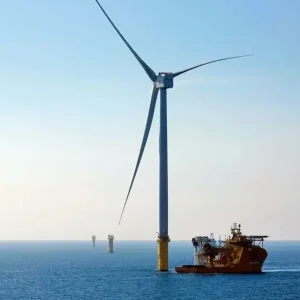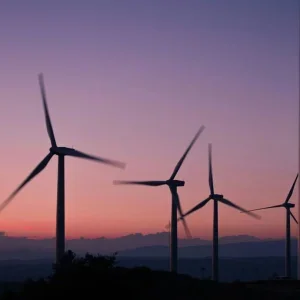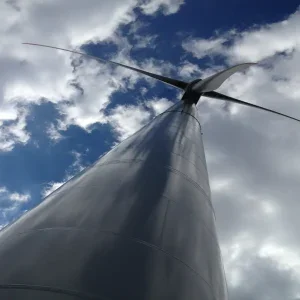Earlier this year, global wind turbine capacity passed the 300GW mark and, if current growth rates continue, this figure could double in half a decade. In the US, where renewable energy sources provide 16.39% of all operational generating capacity, wind accounts for over 5% of the total and the prospects for further growth are very healthy.
In October 2014, wind power constituted nearly 70% of new electrical generating capacity in the US, according to the ‘Energy Infrastructure Update’ report from the Federal Energy Regulatory Commission (FERC), and the recent landmark agreement between the US and China to cut greenhouse-gas emissions will only spur on investment in renewable energy.
To a large extent, the growth of wind energy in the US has been encouraged by the production tax credit (PTC) for renewable energy, which was a major factor behind the tripling of the country’s wind generation capacity between 2007 and 2012. The PTC provides a 2.3-¢ per kilowatt-hour (kWh) incentive for the first ten years of a renewable energy facility’s operation. Although the PTC for wind and other renewable energy technologies expired at the end of 2013, eligible projects that were under construction before 1 January 2014 still qualify for it and there is significant support for extending the deadline.
"Growth is likely to continue and there will be a pretty significant bump during 2015 as PTC installations continue," says Dalen Copeland, director of business development for operations and maintenance (O&M) at EDF Renewable Services. "The tax incentives may be reduced and the legislation supporting renewable energy may change, so we may see growth slowing after that in the US, but there is still a lot of potential in Canada. We are also looking closely at South America."
As well as new capacity, the onus is on operators to keep existing installations running efficiently, particularly as an increasing number of turbines are approaching the end of their warranty period.
Typically, manufacturers’ warranties tend to last up to five years, while the expected lifespan of a standard wind farm is usually more like two decades. It is no surprise, therefore, that as warranties have expired on more than half of the turbines that are currently in operation.
As a result, there are great opportunities for service providers in the O&M sector, for which the estimated market could exceed $13 billion in revenue by 2020, when global installed wind capacity could be as much as 700GW. Many industry analysts believe that the O&M market could see double-digit growth for at least the next five years, which means that competition will intensify.
"Wind turbines are subject to as much stress as any machine in the world, so they face unique challenges, and there will always be opportunities for growth in the O&M space," Copeland believes.
Counting on experience
EDF Renewable Energy already provides services to 8,500MW of installed capacity in North America. It is the largest provider of third-party O&M on continent and its team is responsible for the upkeep of more than 6,650 turbines, in excess of 40 different types of equipment and over 600 inverters.
The subsidiary of EDF Energies Nouvelles has a long history as one of the market leaders in O&M and provides a valuable hands-on experience for its parent company’s global operations. Unlike some of its competitors in the O&M space, the company has been active in the US wind industry since its start, having been involved with early installations in California 27 years ago.
"Back in the 1980s, the tax incentives were for investment, rather than production," says Copeland. EDF Renewable Energy identified a niche and wanted to help people who intended to produce energy. There was a long period of shakeout among those providing services, and many disappeared, the company stepped in and were later brought under the wing of EDF," says Copeland.
"The organisation has great breadth and depth. Some people have been in it for 25 years and have worked with turbines, and so have great knowledge. Its competitors are either OEMs, or other independent service providers. EDF Renewable Energy is different from the OEMs because O&M is its core business, so while others may not be interested in selling service agreements, that is all EDF Renewable Energy does. Also, it can be transparent about what is wrong, because it didn’t design the machines. It also has the experience to capture efficiencies, because a lot of knowledge has been passed down over the years," she adds.
The company also benefits from having a wind energy development division within the same corporate group, because it can glean valuable lessons from the operational side to inform its O&M strategy.
"EDF Renewable Energy is always looking for opportunities and goes where the market leads, working hand-in-hand with its development organisation, which invests in wind energy production. The asset managers who run the wind farms sit down the hall from the O&M team, so we benefit from that," notes Copeland.
The result is a strategy that is developing to broaden its focus beyond the nuts and bolts of maintenance and repair. Although that side of the business is still vital, particularly with the ever-climbing number of off-warranty turbines, there is an increasingly intense focus on using data as the essential tool.
The company maintains a highly skilled engineering workforce across its operation control centres (OCCs) that cover not only the mechanical side of maintenance and inspection, but also the design and creation of data analysis tools to underpin the development of long-term production optimisation technology, as well as data centralisation and remote control of on-site equipment. These OCCs work in tandem with local maintenance branches.
From wrench to keyboard
The evolution of O&M is happening in part because the technology used in turbines is becoming more reliable. Permanent, direct-drive turbines are taking market share from those with gearboxes because they are less expensive to maintain.
Gearbox failures are one reason behind the move by turbine manufacturers such as Siemens and GE towards permanent magnet direct-drive turbines, while the likes of Enercon are making annular multipole generators, which contain fewer moving parts.
The improved reliability and lower maintenance costs offered by these technologies offer could reduce demand for traditional O&M services, so it is vital that independent service providers stay ahead of the game.
"There have been shifts in the market over the years and the owner mix has changed," explains Copeland. "Before, there were debt or equity players that owned projects along with independent power producers or utilities. Now, there are more pure financial players and they have different needs as they are not as close to the operations side.
"EDF is able to offer asset administration services; the owner makes the big decisions and my company deals with the rest, which includes everything from invoicing contractors to making payments.
"Technology in the renewable energy space has become more sophisticated, and most projects are now much more reliable, so the aim is to fine-tune each operation and increase the efficiency of production. Growth is now more on the keyboard side, which is about the use of data to make better business decisions, rather than on the wrench side, which is the repair of equipment. Greater reliability of equipment means we need to become more focused on data to get assets producing more in the environmental conditions in which they have been installed."
Practice makes perfect
Operators have a choice when it comes to O&M. They can do it themselves, which can be costly and complicated. Alternatively, they can choose to go to equipment manufacturers, which have ready access to spare parts, but this can prove expensive over the long term compared with independent service providers that price competitively and often have deep pools of experience upon which to draw.
Whether or not independent service providers are ultimately chosen by operators will increasingly depend on how innovative a service they deliver and how they are able to manage and analyse production data.
The next step in innovation will be the development of predictive and corrective maintenance on the basis of in-depth incident analysis, troubleshooting, stock handling and risk management.
This is an area in which other industries have taken the lead and to which companies like EDF Renewable Services can look when defining best practice. There is a long way to go before this type of service is commonplace, but is likely to be a key battleground for O&M service providers in the next few years.
"Predictive maintenance is in its infancy in megawatt-class turbines as the moment, but we can learn a lot from industries such as aviation about how to schedule inspection and repairs better," notes Copeland.
There is much to play for in the O&M sector and the winners are likely to be those service providers that can look back on a rich history to define a long-term strategy for the future.






